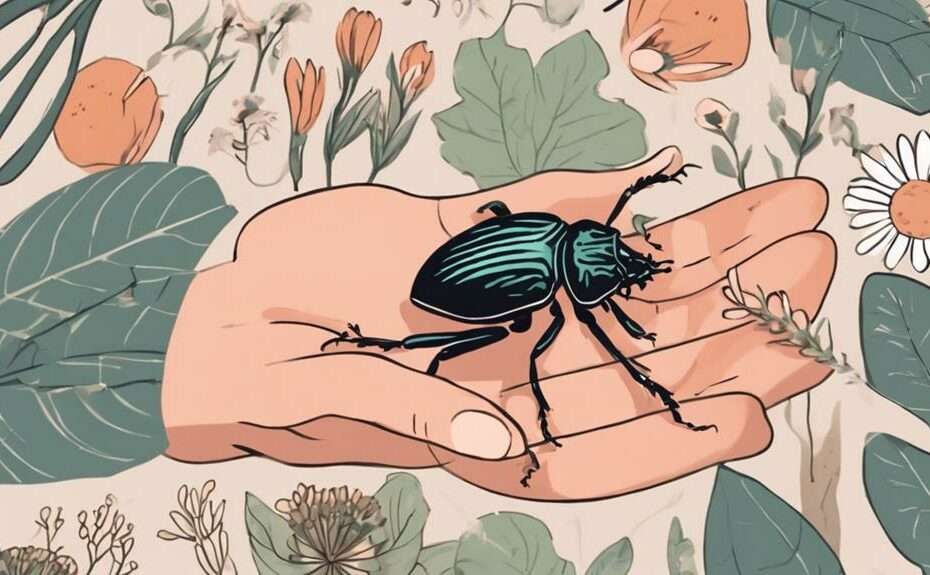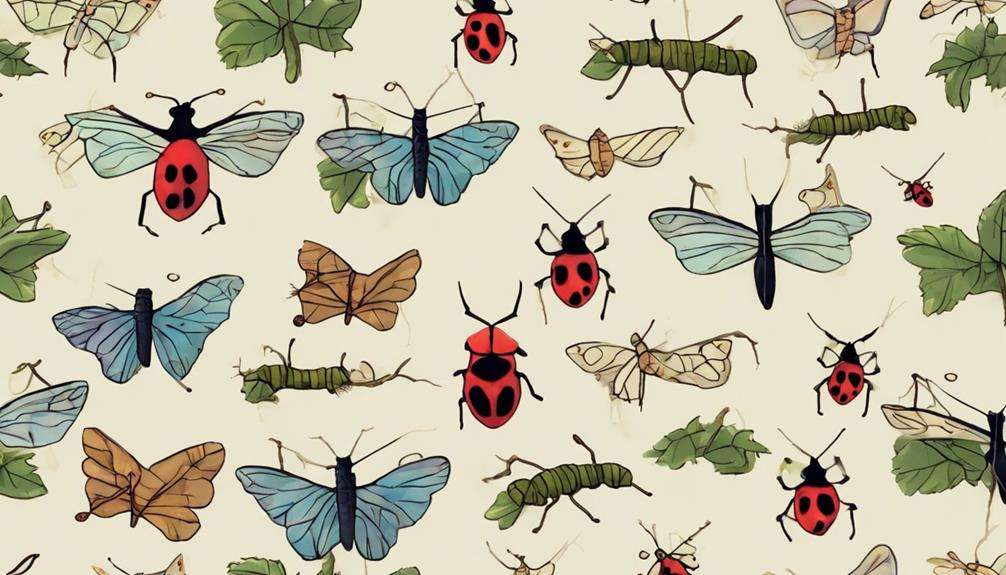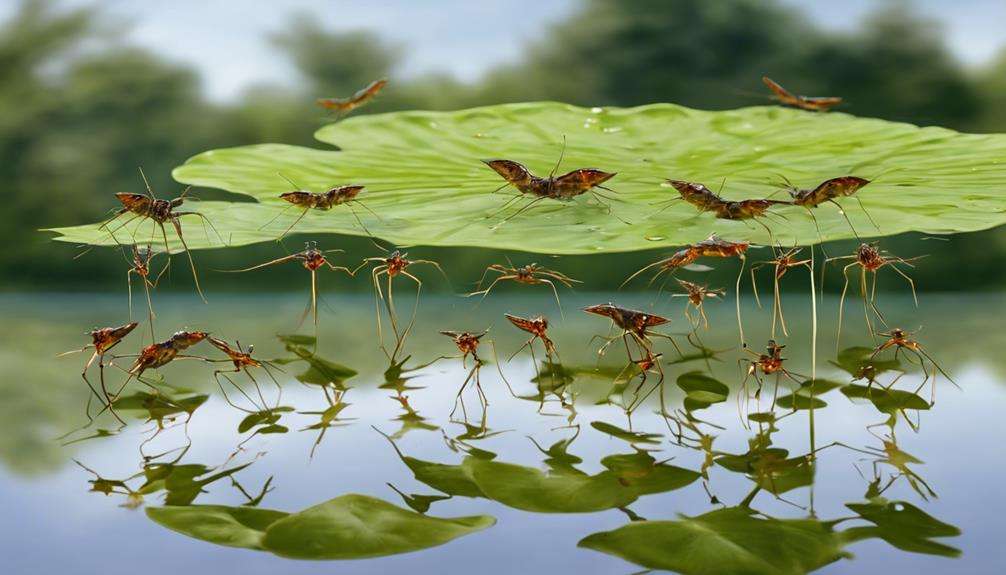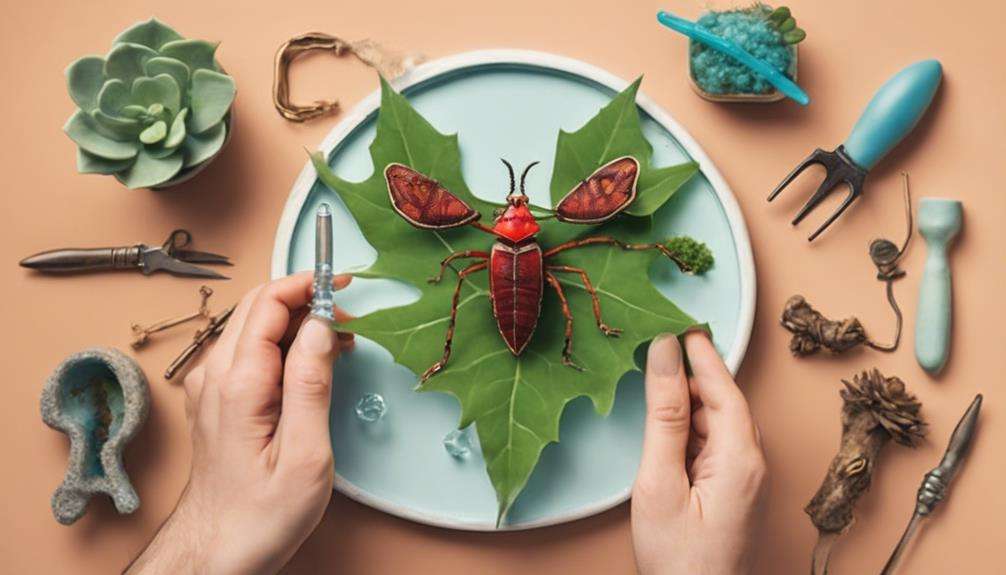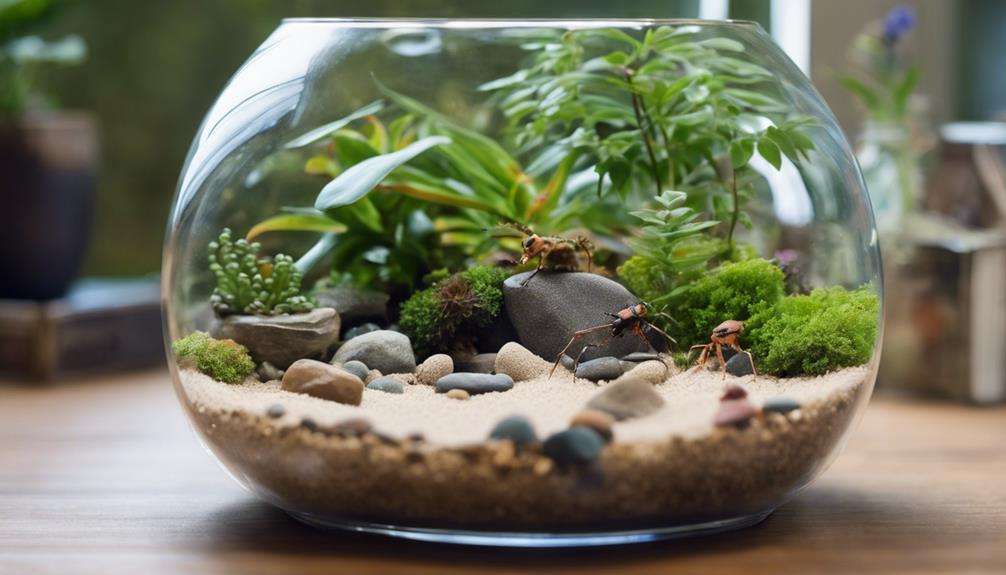When caring for flower beetles, striking a balance between proper habitat setup and meticulous attention to their dietary requirements is key.
But what about the other essential tips that can make a significant difference in the well-being of these fascinating creatures?
Understanding how to navigate through the complexities of temperature regulation, health maintenance, and successful breeding strategies could be the missing piece in ensuring you provide top-notch care for your flower beetles.
Key Takeaways
- Provide a spacious and suitable environment for breeding and egg laying
- Offer a balanced and nutritious diet to support longevity and vitality
- Maintain optimal temperature, humidity, and breeding conditions for successful reproduction
- Monitor closely for signs of illness, stress, and behavioral changes for prompt care and adjustments
Proper Housing Setup
When setting up the housing for your flower beetles, make sure to provide a spacious terrarium measuring at least 12x12x12 inches to accommodate their needs. This size guarantees ample room for the beetles to move around comfortably and exhibit their natural behaviors. Within this habitat, it's essential to create suitable conditions for egg laying, a critical aspect of the beetle's reproductive cycle.
For successful egg laying, incorporate a substrate mix of coconut coir, peat moss, and decayed wood in the terrarium. These materials not only provide a suitable medium for the beetles to lay their eggs but also help maintain proper humidity levels between 50-60%, important for the development of healthy eggs. Additionally, include hiding spots and climbing surfaces within the terrarium to offer the beetles options for laying their eggs in a secure and preferred environment.
Appropriate Diet and Nutrition
To guarantee the best health and development of flower beetles, it's critical to provide a balanced diet consisting of various foods. This includes beetle jelly, fruits like banana and apple, and mashed vegetables. Beetles eat a variety of foods, including beetle jelly, fruits like banana and apple, and mashed vegetables. It's important to avoid feeding them citrus fruits as these may not be well tolerated.
By offering small food quantities, you can prevent spoilage and make certain that the beetles receive essential nutrients. Supplementing their diet with occasional protein sources such as mealworms or commercial beetle food can benefit their overall health and well-being. Regularly monitor the food consumption of flower beetles to adjust feeding quantities accordingly. This practice helps maintain a healthy diet for top growth and development.
Providing a diverse and nutritious diet is key to supporting the longevity and vitality of your flower beetles.
Optimal Temperature and Humidity
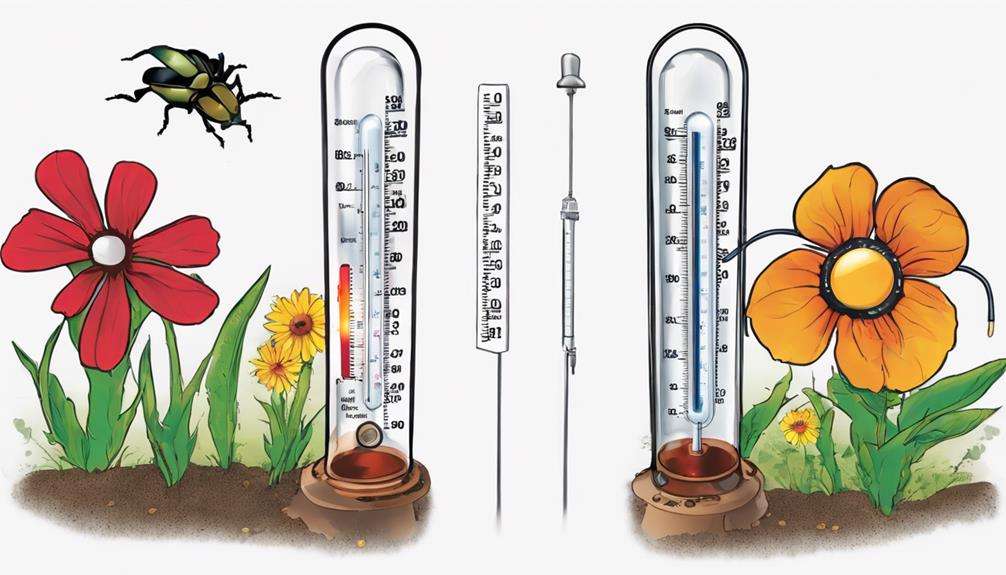
To guarantee the well-being of your flower beetles, maintaining temperatures between 72-80°F is critical for their breeding and development.
Additionally, keeping humidity levels within the range of 40-50% is essential for their overall health.
Consistent monitoring and adjustment of these factors will create an ideal environment for successful breeding and larval growth of your flower beetles.
Temperature for Beetles
Maintain the best temperature range of 72-80°F for breeding and caring for adult flower beetles to guarantee their well-being and reproductive success. Beetles are ectothermic, meaning they rely on external temperatures to regulate their metabolic processes. Extreme temperatures can stress or even harm flower beetles, so it's important to keep their environment stable.
Fluctuations outside the recommended range can disrupt their feeding, mating, and overall behavior. By providing a consistent temperature within the best range, you create an environment where beetles can thrive. Monitoring and adjusting the temperature accordingly will support their health and contribute to successful breeding outcomes.
Humidity Levels Needed
Maintaining the appropriate humidity levels within the range of 40-60% is important for ensuring the best possible health and well-being of flower beetles, complementing the significance of maintaining suitable temperatures for their care.
Adequate humidity helps prevent dehydration in flower beetles and supports their overall physiological functions. Insufficient humidity can induce stress, reduce breeding success, and lead to health issues in these beetles.
Conversely, high humidity levels exceeding 60% can create conditions conducive to mold growth and other moisture-related problems within flower beetle enclosures. Hence, it's essential to regularly monitor and adjust humidity levels to provide a comfortable and healthy environment for your flower beetles.
Regular Monitoring and Observation
To guarantee the well-being of your flower beetles, it's crucial to closely observe their behavior and habits.
Monitor their movements, feeding patterns, and interactions to detect any signs of illness or stress early on.
Regular observation is key to maintaining the health and happiness of your flower beetle companions.
Observation Is Key
Regularly monitoring and observing your flower beetles is essential for ensuring their well-being and detecting any issues early on. By consistently monitoring their behavior, activity levels, and overall health, you can identify signs of stress, illness, or abnormalities promptly.
Pay close attention to their feeding habits, substrate condition, and breeding activity through regular observation. Any changes in behavior, appetite, or appearance should be noted to address potential issues without delay.
This proactive approach allows you to make necessary adjustments in their care and environment, ensuring that your flower beetles receive the best conditions for thriving. Remember, observation is key to maintaining the health and happiness of your flower beetles.
Monitor Behavior Closely
Observing your flower beetles' behavior closely is important for their well-being and overall health maintenance. Regularly monitor behavior closely by observing their feeding habits, interactions, and activity levels within the enclosure.
Look out for any signs of stress, aggression, or unusual behavior that may indicate underlying health issues. Keep a close eye on their movements and any changes in appearance, such as coloration or posture, to guarantee they're thriving.
Document any notable behaviors or patterns to track their well-being and make informed care decisions. By monitoring their behavior closely, you can proactively address any potential issues and provide a conducive environment for your flower beetles to flourish.
Handling and Interaction Guidelines
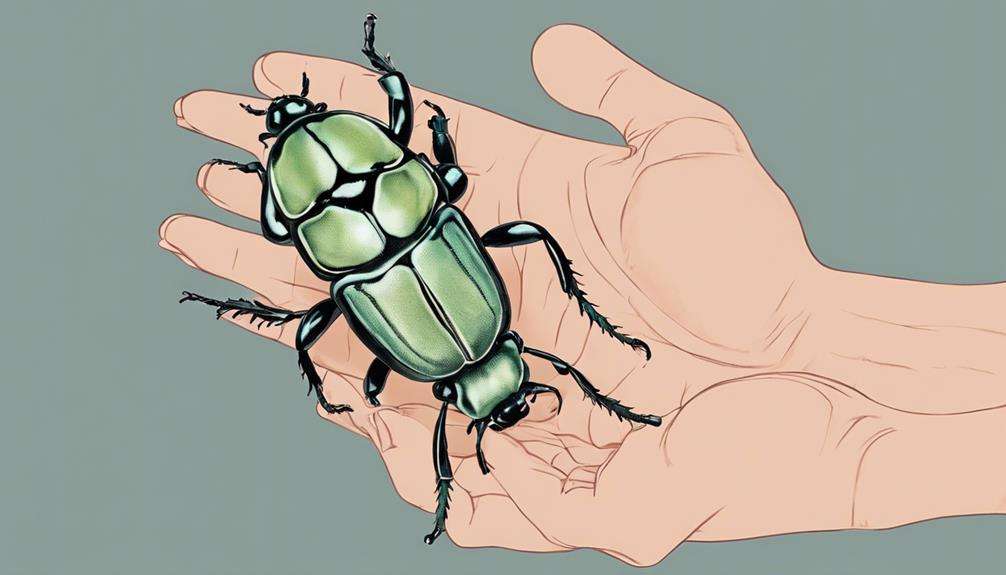
When handling flower beetles, remember to use a soft paintbrush or tweezers for delicate interactions to avoid stressing or injuring them. Adult flower beetles are sensitive creatures, and it's important to handle them gently to guarantee their well-being.
By using a soft paintbrush or tweezers, you can minimize the risk of causing harm or distress. Avoid direct contact with the beetles to prevent accidental injuries or damage to their delicate bodies. It's advisable to limit handling as much as possible to reduce the likelihood of injury to the beetles.
When transferring or moving flower beetles, exercise caution to prevent them from escaping or getting hurt. By following these handling and interaction guidelines, you can provide the best care for your flower beetles and promote their health and happiness. Remember, a gentle touch goes a long way in fostering a positive relationship with these fascinating insects.
Preventing Common Health Issues
To guarantee the well-being of your flower beetles, it's essential to monitor the larvae for signs of stress and take preventive measures to avoid common health issues. Keeping a close eye on the larvae for any sluggish movement or discoloration can help you catch any potential problems early.
Also, make certain that the substrate in the breeding box isn't overly wet to prevent issues like mold and fungal growth, which can be harmful to the larvae. Adequate ventilation is important to avoid respiratory problems, so make sure the breeding box is well-aerated.
Overcrowding should also be avoided as it can lead to competition for resources and increased stress on the larvae. Regularly cleaning and sanitizing the breeding box is important to prevent the spread of diseases and to maintain a healthy environment for the larvae.
Breeding and Reproduction Tips
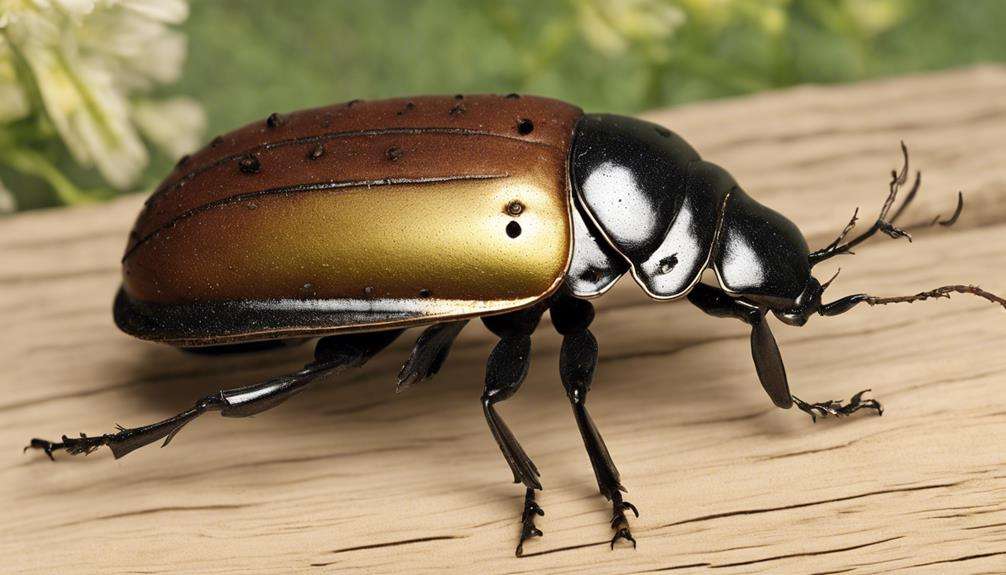
For best breeding success with flower beetles, make sure there are plenty of hiding spots and wood substrates available in the breeding environment. These elements are essential for providing the beetles with suitable conditions for mating and egg-laying.
Maintaining specific humidity and temperature levels is vital for successful reproduction. Female flower beetles typically lay their eggs in the substrate, where the larvae will develop.
Implementing effective breeding techniques, such as providing the right diet and monitoring environmental conditions, is key to ensuring a thriving beetle population. It's important to observe the behavior and activity of the beetles closely to identify signs of successful breeding, such as increased mating behavior or the presence of eggs in the substrate.
Frequently Asked Questions
How Do You Take Care of a Flower Beetle?
To care for a flower beetle, ascertain proper habitat requirements. Provide a spacious terrarium with hiding spots. Maintain humidity levels at 50-60%. Offer decaying organic matter and ripe fruits. Clean regularly and observe beetle well-being.
How Do You Take Care of Beetles?
When caring for beetles, maintain stable temperatures for best health. Provide a suitable habitat with hiding spots and food sources. Minimize handling to reduce stress. Regularly clean to prevent mold growth. Monitor beetle behavior for signs of distress.
How Do You Set up a Flower Beetle?
To set up a flower beetle habitat, choose a spacious terrarium. Create a substrate mix of coconut coir, peat moss, and decayed wood. Maintain humidity at 50-60%, provide hiding spots, climbing surfaces, and stable temperatures between 70-85°F.
What Do Flower Beetles Eat?
Flower beetles have varied dietary preferences, consuming decaying plant matter and benefitting from supplementary foods like ripe fruits and vegetables. Offering small food quantities prevents spoilage and guarantees a balanced diet for these beetles.
Conclusion
To sum up, by following these essential tips for caring for flower beetles, you can guarantee their health and well-being.
For example, a breeder noticed a decline in breeding success due to inadequate substrate moisture levels. By adjusting the humidity and regularly monitoring the conditions, they were able to improve breeding outcomes and guarantee the larvae's development.
Remember, attention to detail and proactive care are key to successfully caring for flower beetles.
